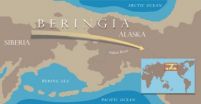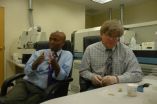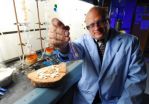(Press-News.org) CHAMPAIGN, Ill. — A new study could help resolve a longstanding debate about the origins of the first people to inhabit the Americas, researchers report in the journal Science. The study relies on genetic information extracted from the tooth of an adolescent girl who fell into a sinkhole in the Yucatan 12,000 to 13,000 years ago.
The girl's remains were found alongside those of ancient extinct beasts that also fell into the "inescapable natural trap," as researchers described the sinkhole. The team used radiocarbon dating and analyzed chemical signatures in bones and in flowerlike crystals that grew on the bones to determine how long ago the girl lived.
Scientists have long debated the origins of the first Americans. Most accept – and numerous genetic analyses support the view – that the original immigrants crossed over a land bridge that once connected northeast Asia to present-day Alaska.
The most ancient remains have baffled scientists, however, because the skulls are narrower and have other measurably different features than those of Native Americans. Some researchers hypothesize that these individuals came to the Americas from as far away as Australia or Southeast Asia.
The girl who fell into the sinkhole had a skull with the unusual shape. And, luckily for the researchers, her bones still held genetic material that could be analyzed to determine her origins.
"There are lots and lots of theories about the peopling of the Americas and who was where when," said University of Illinois anthropology and Institute for Genomic Biology professor Ripan Malhi, whose lab was one of three to conduct genetic analyses for the new study. "And it seems like genetic research is slowly falsifying a lot of these theories."
The laboratories of Brian Kemp at Washington State University and Deborah Bolnick at the University of Texas each independently extracted and analyzed mitochondrial DNA from the ancient girl's tooth. Genetic material from the mitochondria (energy-generating structures found in every cell) is more plentiful than that found in the nucleus of cells, and so is easier to study.
Malhi also analyzed the mitochondrial DNA, focusing on regions of the mitogenome that code for specific proteins. These coding regions mutate more slowly than noncoding parts of the genome, and so can be more reliable markers of genetic relatedness.
The Kemp, Bolnick and Malhi labs each independently found that the ancient girl belonged to a genetic lineage that is shared only by Native Americans.
"We were able to identify her genetic lineage with high certainty," Malhi said. "This shows that living Native Americans and these ancient remains of the girl we analyzed all came from the same source population during the initial peopling of the Americas."
Forensic anthropologist, archaeologist and paleontologist James Chatters, of Applied Paleoscience in Bothell, Washington, led the new analysis. Chatters is best known for his work on Kennewick Man, another ancient individual whose origins were debated because his skull was markedly different from those of Native Americans. The Kennewick Man remains were found in Kennewick, Washington, in 1996.
The research was an international effort involving scientists, divers and technicians from more than a dozen institutions.
INFORMATION:
Editor's notes: To reach Ripan Malhi, email malhi@illinois.edu.
To reach Jim Chatters, call 425-770-9641; email paleosci@gmail.com.
The paper, "Late Pleistocene Human Skeleton and MtDNA Link Paleoamericans and Modern Native Americans," is available online. Members of the media may request a copy by emailing scipak@aaas.org. Others may email membership@aaas.org.
Genetic study helps resolve years of speculation about first people in the Americas
2014-05-15
ELSE PRESS RELEASES FROM THIS DATE:
Dating and DNA show Paleoamerican-Native American connection
2014-05-15
Eastern Asia, Western Asia, Japan, Beringia and even Europe have all been suggested origination points for the earliest humans to enter the Americas because of apparent differences in cranial form between today's Native Americans and the earliest known Paleoamerican skeletons. Now an international team of researchers has identified a nearly complete Paleoamerican skeleton with Native American DNA that dates close to the time that people first entered the New World.
"Individuals from 9,000 or more years ago have morphological attributes -- physical form and structure -- ...
Genetic study confirms link between earliest Americans and modern Native-Americans
2014-05-15
AUSTIN, Texas — The ancient remains of a teenage girl found in an underwater Mexican cave establish a definitive link between the earliest Americans and modern Native Americans, according to a new study released today in the journal Science.
The study was conducted by an international team of researchers from 13 institutions, including Deborah Bolnick, assistant professor of anthropology at The University of Texas at Austin, who analyzed DNA from the remains simultaneously with independent researchers at Washington State University and the University of Illinois at Urbana-Champaign.
The ...
First 'heavy mouse' leads to first lab-grown tissue mapped from atomic life
2014-05-15
Scientists have created a 'heavy' mouse, the world's first animal enriched with heavy but non-radioactive isotopes - enabling them to capture in unprecedented detail the molecular structure of natural tissue by reading the magnetism inherent in the isotopes.
This data has been used to grow biological tissue in the lab practically identical to native tissue, which can be manipulated and analysed in ways impossible for natural samples. Researchers say the approach has huge potential for scientific and medical breakthroughs: lab-grown tissue could be used to replace heart ...
One of oldest human skeletons in North America is discovered
2014-05-15
Cave-diving scientist Patricia A. Beddows of Northwestern University is a member of an international team of researchers and cave divers this week announcing the discovery in an underwater Yucatán Peninsula cave of one of the oldest human skeletons found in North America.
Details of "Naia," a teenage girl who went underground to seek water and fell to her death in a large pit named Hoyo Negro ("black hole" in Spanish), will be published May 16 in the journal Science.
"The preservation of all the bones in this deep water-filled cave is amazing -- the bones are beautifully ...
Communicating with the world across the border
2014-05-15
Stanford, CA—All living cells are held together by membranes, which provide a barrier to the transport of nutrients. They are also the communication platform connecting the outside world to the cell’s interior control centers. Thousands of proteins reside in these cell membranes and control the flow of select chemicals, which move across the barrier and mediate the flux of nutrients and information. Almost all of these pathways work by protein handshakes--one protein “talking” to another in order to, for example, encourage the import of a needed nutrient, to block a compound ...
Quantum simulator gives clues about magnetism
2014-05-15
Assembling the puzzles of quantum materials is, in some ways, like dipping a wire hanger into a vat of soapy water, says CIFAR (Canadian Institute for Advanced Research) Fellow Joseph Thywissen (University of Toronto).
Long before mathematical equations could explain the shapes and angles in the soap foams, mathematicians conjectured that soap films naturally found the geometry that minimized surface area, thus solving the problem of minimal surfaces. They could be created simply by blowing soap bubbles.
At the University of Toronto's Ultracold Atoms Lab, Thywissen ...
UNM plays major role in establishing link between ancient and modern Native-Americans
2014-05-15
Her name is Naia, and for thousands and thousands of years, the skeleton of this young woman was buried underwater in an elaborate cave system in the Yucatan Peninsula after she had apparently fallen into what was then a dry deep pit.
Now, a team of researchers, including Professor Yemane Asmerom and Research Scientist Victor Polyak at the University of New Mexico's Department of Earth and Planetary Sciences, have accurately determined the age of the oldest-known, well-preserved human skeleton. Naia was one of the earliest inhabitants of the Americas and has helped resolve ...
Making money from lignin: Roadmap shows how to improve lignocellulosic biofuel biorefining
2014-05-15
When making cellulosic ethanol from plants, one problem is what to do with a woody agricultural waste product called lignin. The old adage in the pulp industry has been that one can make anything from lignin except money.
A new review article in the journal Science points the way toward a future where lignin is transformed from a waste product into valuable materials such as low-cost carbon fiber for cars or bio-based plastics. Using lignin in this way would create new markets for the forest products industry and make ethanol-to-fuel conversion more cost-effective.
"We've ...
UH researchers find definitive evidence of how zeolites grow
2014-05-15
Researchers have found the first definitive evidence of how silicalite-1 (MFI type) zeolites grow, showing that growth is a concerted process involving both the attachment of nanoparticles and the addition of molecules.
Both processes appear to happen simultaneously, said Jeffrey Rimer, an engineering professor at the University of Houston and lead author of a paper published Thursday in the journal Science.
He said a second component to the research could have even more lasting impact. He and researcher Alexandra I. Lupulescu used a new technique allowing them to view ...
Anti-craving drug and counseling lower alcohol harm in homeless, without sobriety demands
2014-05-15
Chronically homeless, alcohol-dependent individuals might benefit from a new intervention that does not require them to stop or even reduce drinking, according to the results of a preliminary study in Seattle.
Participants in the 12-week pilot program received monthly injections of an anti-craving medication, extended-release naltrexone. They also met regularly with study physicians to set their own goals for treatment and to learn to be safer in their use of alcohol.
"Abstinence-based alcohol treatment has not been effective for or desirable to many homeless people ...








